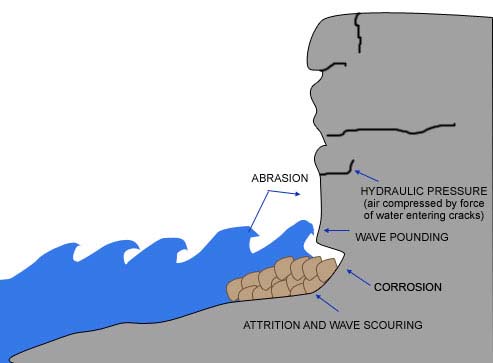Coastal Erosion
Wind, waves, tidal currents, and tsunamis all cause coastal erosion, but waves are by far the most powerful force. Most coastal erosion is caused by destructive wave action. You saw a good example of this in the news video on coastal erosion in Happisburgh, where an entire village is disappearing as ocean waves beat against the soft rock and steep cliffs of the shoreline. A shoreline does NOT have to have cliffs in order to undergo erosion; destructive waves can beat against relatively flat sandy shores, carrying away large loads of sediment as they do. These destructive waves not only carry away sediments, they also wear down the shore in other ways.

Click through the tabs to learn about each of six ways that waves lead to coastal erosion.
Abrasion
Abrasion is like the action of sandpaper. It occurs when rock fragments are hurled at sea cliffs by breaking waves, gradually wearing down the sides of the cliffs. The little pieces of rock and sand that strike the cliff grind against it, just like sandpaper grinds away at a piece of wood.
Hydraulic Pressure
Hydraulic pressure occurs when the pressure of breaking waves compresses air inside tiny rock cracks; the compressed air exerts a force on the rock and gradually breaks open the cracks and weakens the rock. It is like filling up your bike tires with too much air. The more air you insert, the more your bike tires expand outward. As they expand outward, they thin and weaken. The rocks along the coast thin and weaken as they are filled with compressed air that exerts a force on them.
Wave Pounding
Sling a pile of loose soil into a bucket of water; you will see some of the soil break apart and fall downward just from the impact with the water. Wave pounding is the loss of shoreline material as a result of the constant pounding of breaking waves.
Corrosion
Have you ever heard about how important it is to wash the underside of your car after driving on winter roads that have been covered with salt to help melt the snow? That’s because salt can build up underneath cars and eat away at the parts. This action is called corrosion. The salt in seawater also corrodes the rocks it hits. Corrosion occurs when the salty seawater dissolves some of the rocks along the shoreline. Slightly acidic seawater has the same effect.
Attrition
Attrition occurs when sand grains grind against each other, gradually reducing in size and becoming easier to wash away.
Wave Scouring
Wave scouring occurs at the base of a cliff, where waves swirl around and loosen material. The action is similar to swirling around a mug of hot cocoa in order to get all the cocoa powder dissolved in your milk. The swirling action accelerates the movement of materials and hastens coastal erosion.
Which of these processes do you think is most common along rocky coasts with steep cliffs? Which would be more common along flatter coasts with sandy shores?